
The Bottom Line
Introduction, Specifications, and Pricing
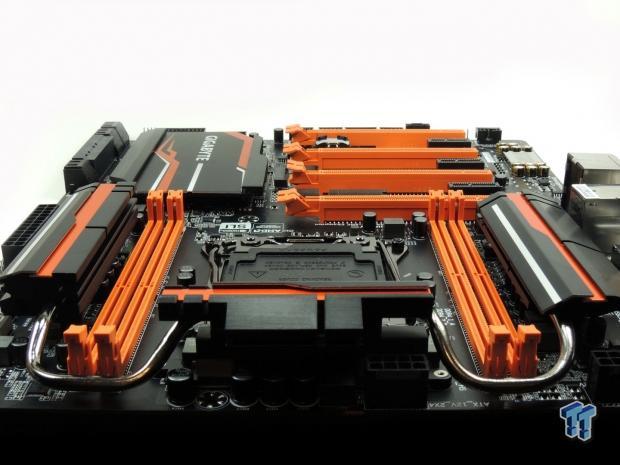
GIGABYTE has one of the largest X99 motherboard fleets in the retail market. Instead of leaving just a few models to satisfy their customers, they tend to tailor their segments to better target their end users' needs. GIGABYTE has come out with G1 Gaming, SOC Overclocking, and Ultra Durable lines. While each type of board is specifically targeted towards gamers, overclockers, or power users, all of the boards cross over into each other's domains.
GIGABYTE's overclocking boards carry upgraded audio, and their gaming boards carry overclocking features; their main series carries both. However, as you get deeper into their product structure, certain products offer features that don't exist on other lines, and the X99-SOC Champion is a perfect example of that.
There has been a lot of debate over the socket GIGABYTE is using. It isn't the standard Intel recommended socket, but at the same time, it is. GIGABYTE has added a switch to switch over from the LGA2011-V3 grid to the LGA2083 grid. The benefits of this socket are really only applicable to extreme overclocking, as the extra pins coupled with the right settings only really help increase settings that are beneficial to those using sub-zero cooling. To avoid confusion, I will refer to this new socket as the LGA2083 socket, and I will cover how to use it and what it improves later on in this review.
Specifications
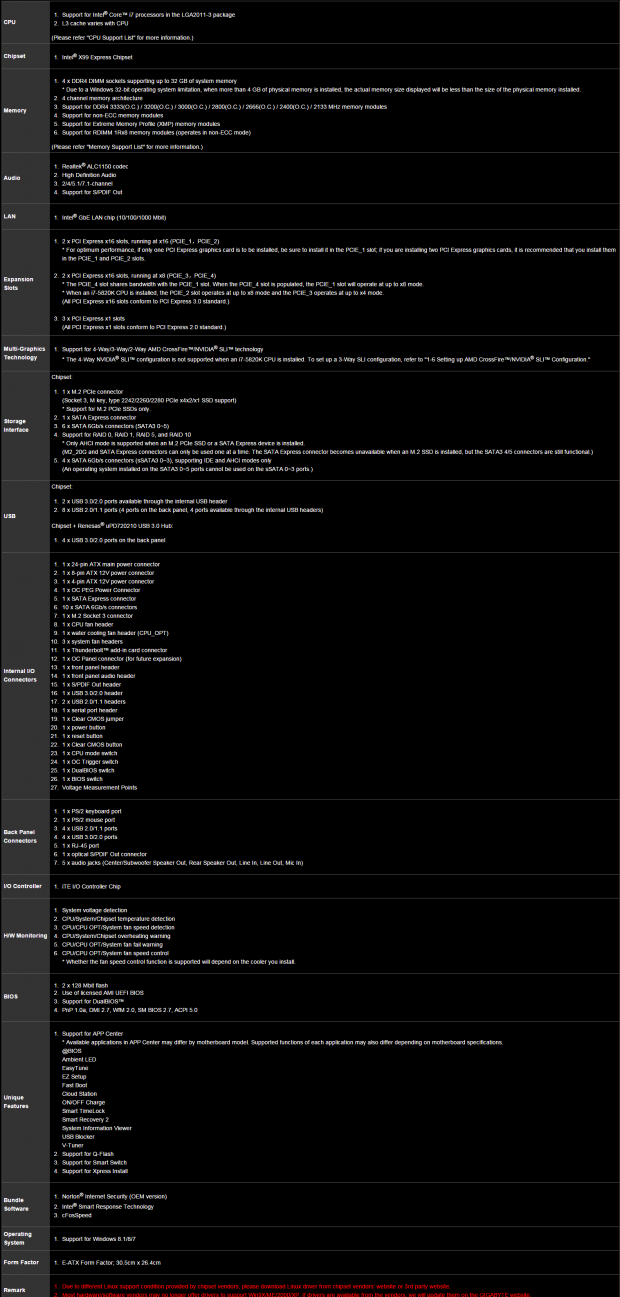
Here are the manufacturer specifications. The X99-SOC Champion and X99-SOC Force are the only two GIGABYTE motherboards that carry 4x PCI-E 2.0 for the M.2 slot, and like all other GIGABYTE boards, the X99-SOC Champion carries the same PCI-E layout capable of 4-way SLI/CF. There is one thing that this board doesn't have, and that is GIGABYTE's USB BIOS rescue; however, Dual BIOS is still present.
Pricing
The X99-SOC Champion is only $300 on Amazon at the time of this review, which is cheaper than the X99-SOC Force was. The Force seems to be moving out in favor of the Champion. The Champion board is built to break records.
For $300, it is a very attractive motherboard since the other options for world-record capable boards are closer to $500. You really have to be an overclocker to recognize the value of this motherboard; otherwise, just looking at the specs won't do you any good.
PRICING: You can find the X99-SOC Champion for sale below. The prices listed are valid at the time of writing, but can change at any time. Click the link to see the very latest pricing for the best deal.
United States: The X99-SOC Champion retails for $299.99 at Amazon
Australia: The X99-SOC Champion retails for $539.00 at PLE Computers.
Packaging and the X99-SOC Champion
Packaging and the Board
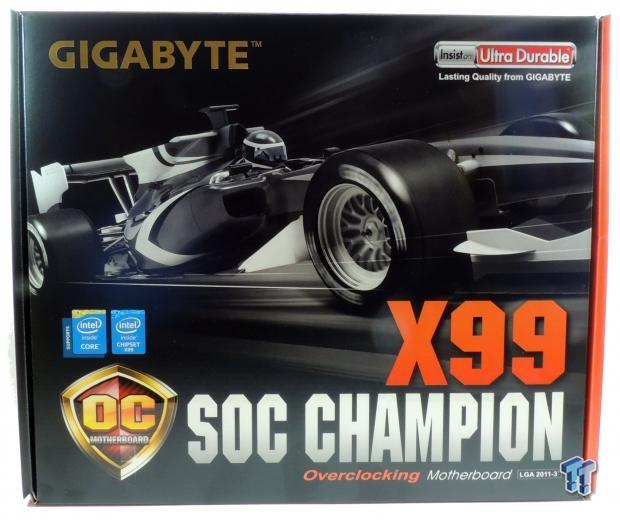
The X99-SOC Champion reduces costs where overclockers don't really care, and increases quality where they do care. The box is a good example of such a cost reduction since the box isn't anything special. This box is actually a bit smaller than the X99-SOC Force box.
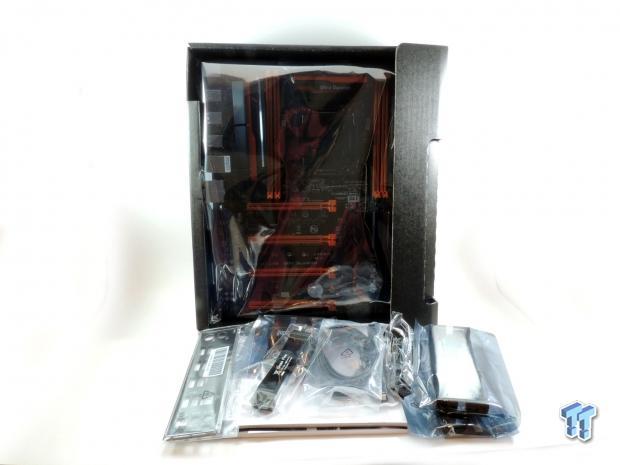
Despite the obvious cost reductions, GIGABYTE did a decent job with packaging. The board is in an anti-static bag instead of a box.
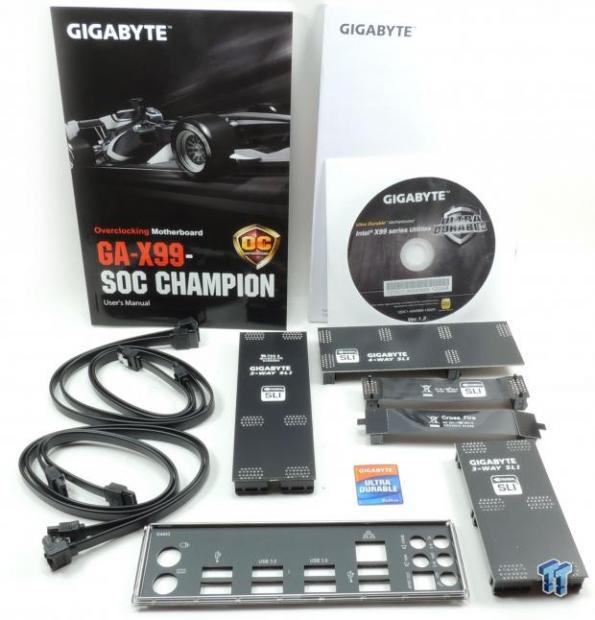
Included accessories are as follows: four SATA6G cables, 2-way SLI and CrossFireX bridges, two different 3-way SLI Bridges, one 4-way SLI bridge, one I/O shield, one driver DVD, manuals, and one case sticker.
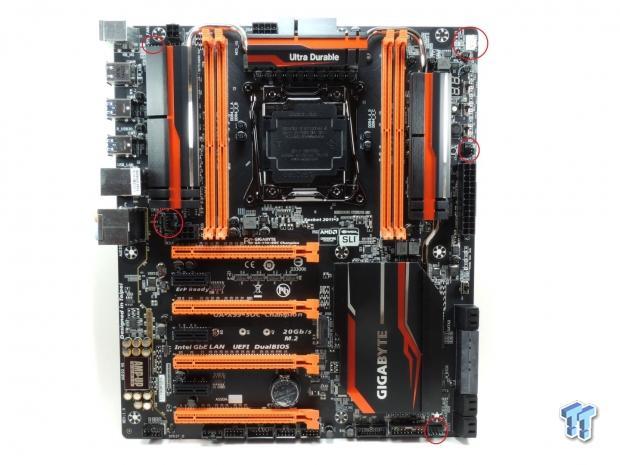
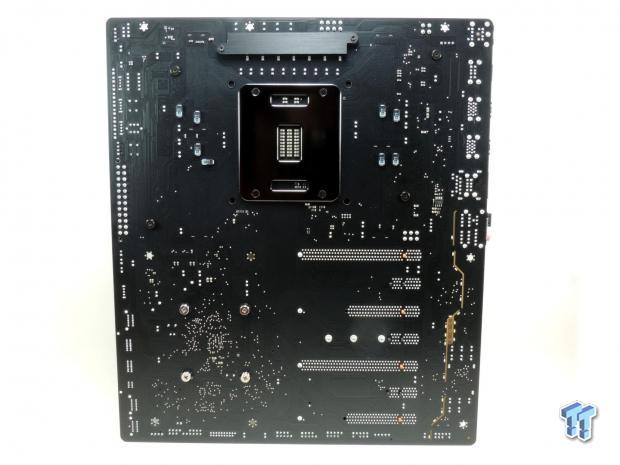
I have circled the fan headers on the board. There are a total of five fan headers, and only the CPU fan header supports PWM control; the remaining headers support voltage mode, which is backwards compatible with PWM. The motherboard's heat sinks intrigue me. It looks like a RAM with horns - a beast determined to wreck world records.
The back of the motherboard is clear of components with the exception of some extra capacitors for the memory signals. The X99-SOC Champion also has SMD DIMMs designed to enhance overclocking performance. GIGABYTE chose to isolate the audio on this motherboard as well, which is an interesting choice considering this board isn't built specifically for gaming.
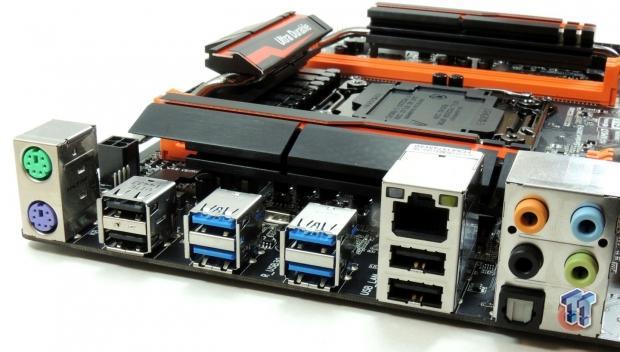
The back-panel I/O features a 1GBit NIC, four USB 3.0 ports, four USB 2.0 ports, a PS/2 keyboard and mouse, and a 7.1 TOSLINK for audio with S/PDIF out.
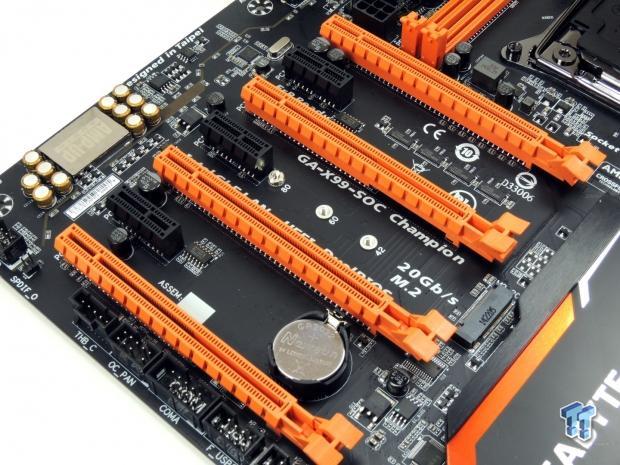
The PCI-E layout on this motherboard is optimized for multi-GPU configurations. All of the PCI-E bandwidth from the CPU reaches the slots, and does so almost without delay. The third and fourth slots are hardwired 16X/8X.
The first slot has its first 8X hardwired to the CPU, and the second 8X can be shared with the second PCI-E slot if needed. You can run 3-way in multiple configurations, especially when you have a 28-lane CPU installed, and that is why GIGABYTE provides two 3-way SLI bridges with different slot spacing.
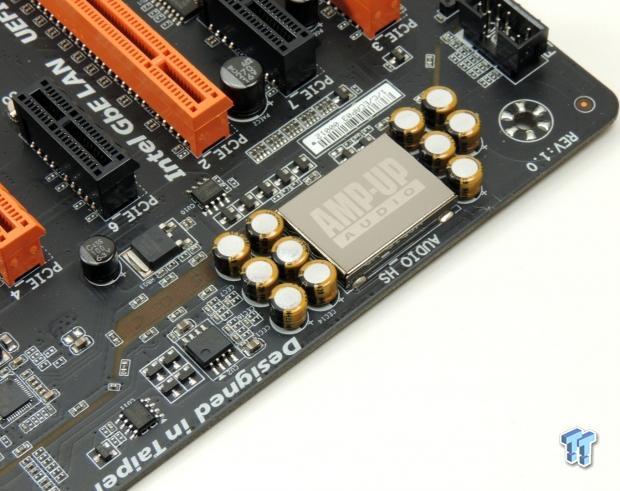
I was surprised to see GIGABYTE provided upgraded audio on this motherboard. There are LEDs on the backside that illuminate the PCB isolation, upgraded Nichicon audio capacitors, and an amplifier for the back-panel headphone port.
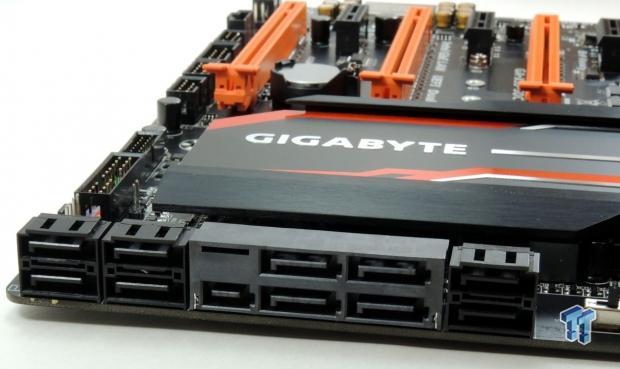
The X99-SOC Champion carries the maximum number of Intel SATA 6G ports and SATAExpress.
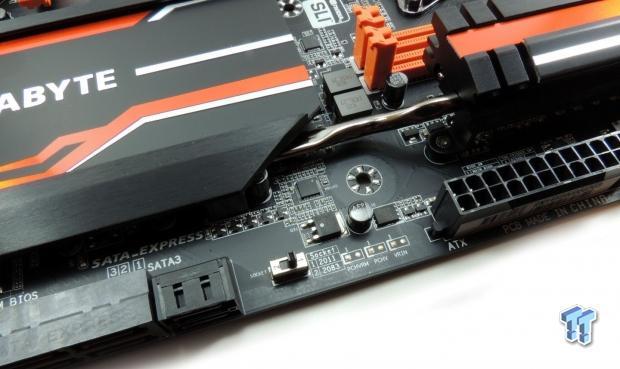
Here is the switch that allows both CPU socket configurations. Switching the switch to the LGA2083 socket can help increase Uncore overclocking and reduce the system agent voltage needed for memory overclocking. I will cover the specifics later in this review.
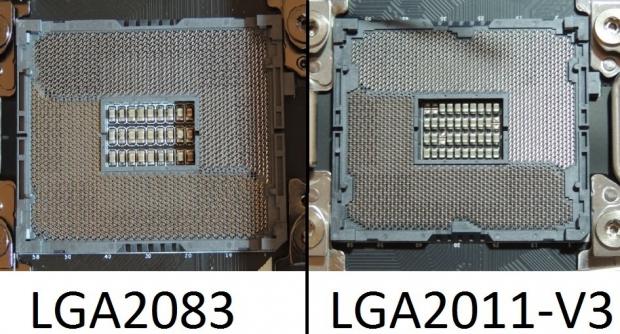
Here you can get a glimpse of the difference between the normal LGA2011-V3 socket and the socket on the X99-SOC Champion.
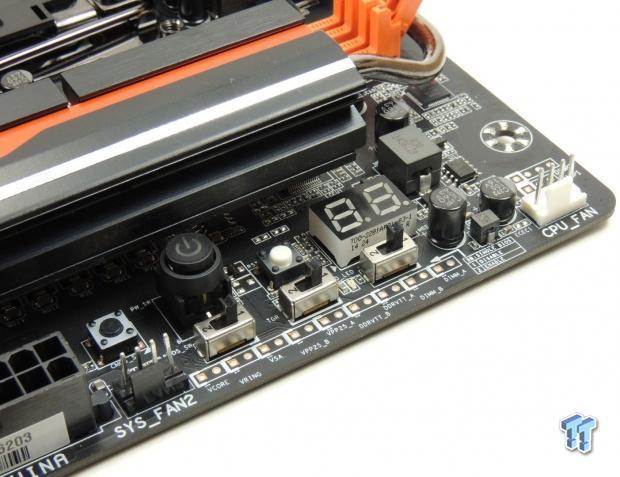
The OC features on the X99-SOC Champion are more limited than those on the X99-SOC Force; however, you don't really need much more than these features. GIGABYTE provides the crucial POST code display, power, reset, clear CMOS, Dual BIOS selector, single BIOS mode, and trigger switches. Voltage read points have also been expanded to include VCore, VRing, and VCCSA, which weren't present on the X99-SOC Force; you can't really probe around for these features either since they are integrated into the CPU.
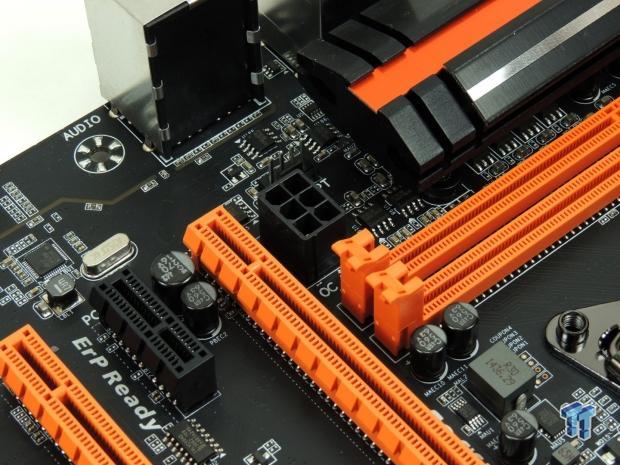
Here is a power port for extra power for the PCI-E slots; this allows you to run 4-way SLI/CrossFireX.
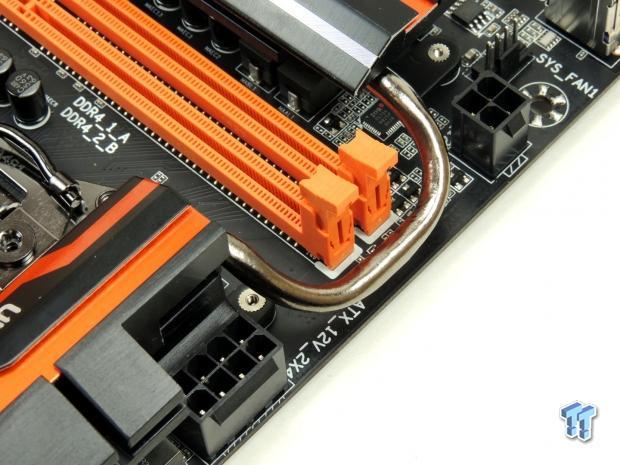
An extra power connector for the CPU power is also included instead of an eight-pin expander like the one you might find on other GIGABYTE motherboards.
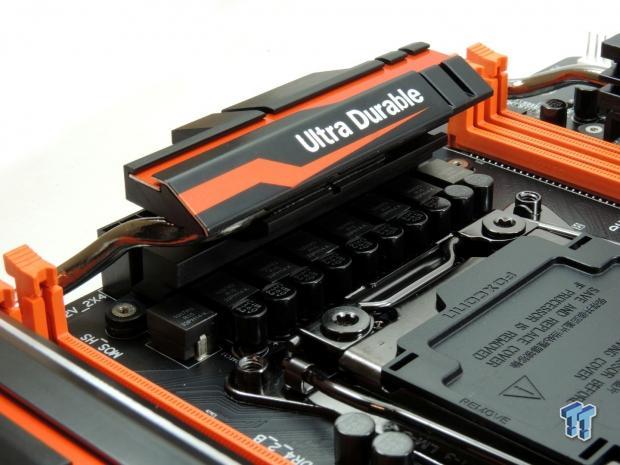
The VRM is the same exact VRM as on other GIGABYTE X99 eight-phase motherboards like the X99-SOC Force and X99-G1 Gaming.
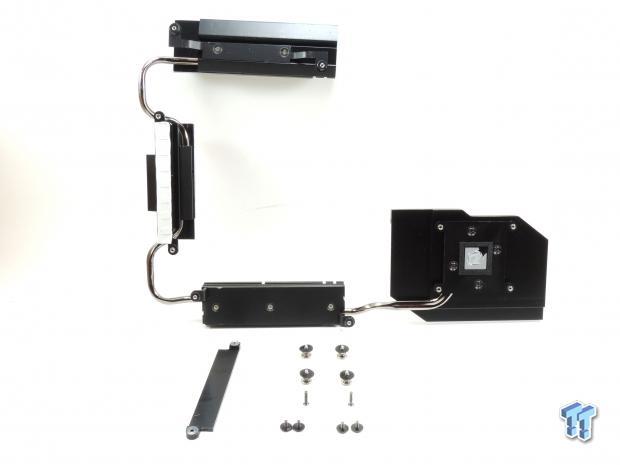
The heat sink is one solid piece and uses screws to hold everything down. You will notice that the CPU VRM heat sink and the PCH are the only ones that make contact to components; the rest are just used to increase cooling capacity.
X99-SOC Force Circuit Analysis
Circuit Analysis
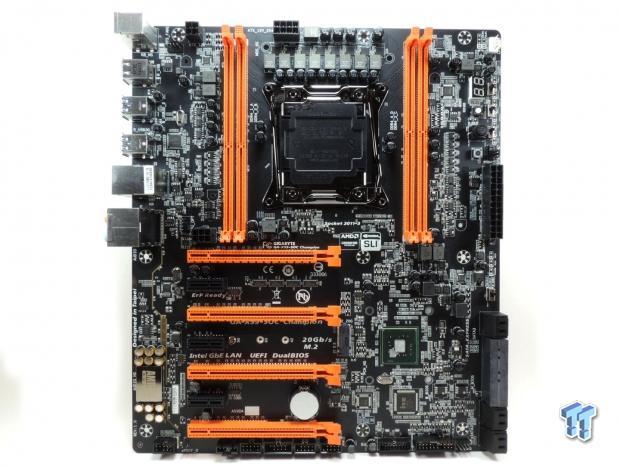
In this section I will begin with a discussion of the voltage regulators, and then move to other important circuits.
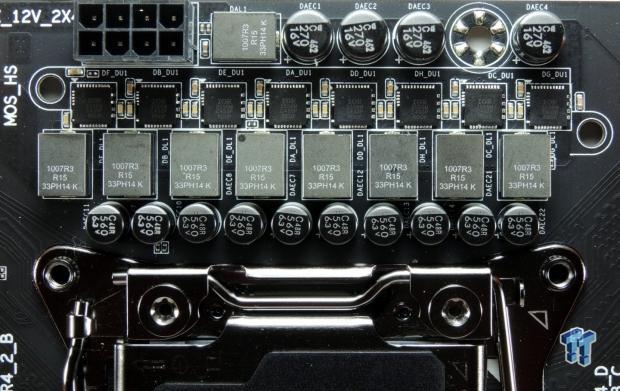
The VRM on this board is powered exclusively by International Rectifier, which is one of the preferred manufacturers for overclockable VRMs. An IR eight-phase digital PWM is utilized to its maximum coupled with IR power stages. The inductors are also interesting because they are capable of 76A saturation current; the Cooper-Bussmann inductors provide high-power density, which is very important with X99. There are ten Nippon Chemi-Con polymer capacitors rated at 10K that provide a total of 5600uF for the output filter.
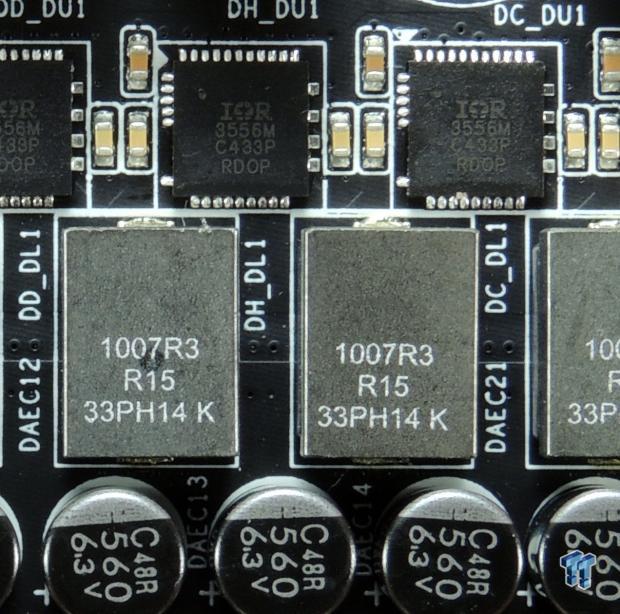
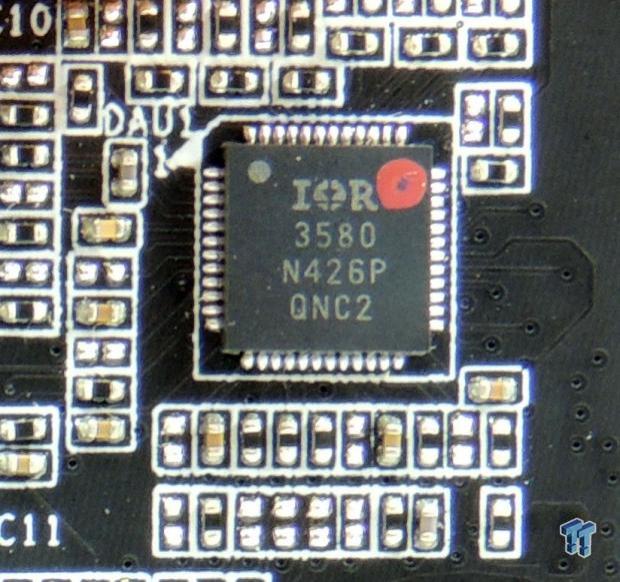
The IR3580 is an eight-phase digital PWM with IR's latest technology built into it. The PWM works well with IR3556, which are 50A integrated power stages. Using all International Rectifier parts allows certain International Rectifier technologies to be utilized, such as the Body-Breaking mode, to turn both internal MOSFETs off to increase overall efficiency.
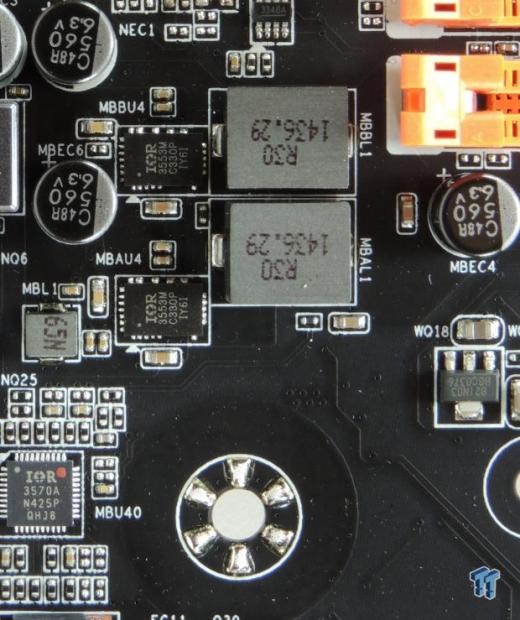
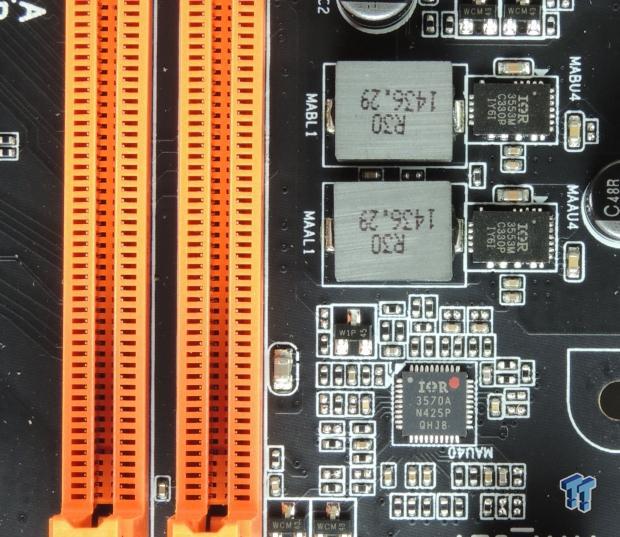
Each set of two DIMMs has its own IR3570, which is a 3+2 phase digital PWM. It is being utilized as a 2+1 phase PWM. The first two phases power the main DDR4 voltage rail, and the +1 powers the VPP rail. Both the main DDR4 voltage and the VPP are powered by IR3553, which are 40A integrated power stages.
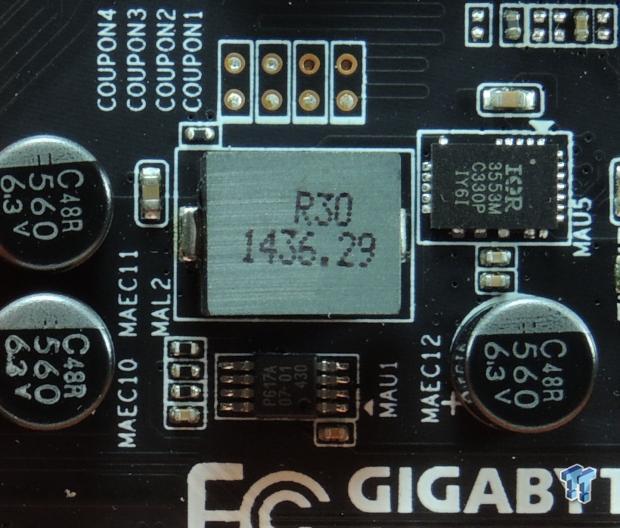
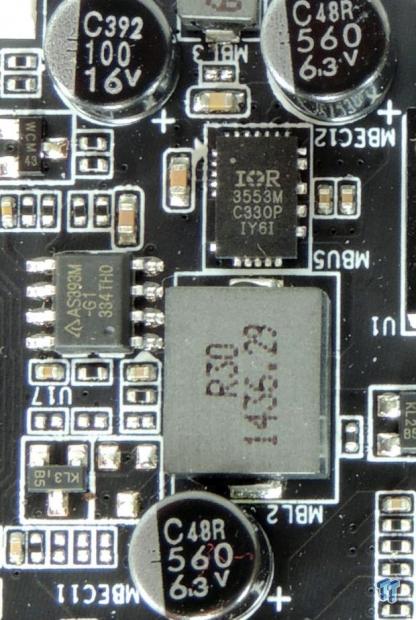
These are the IR3553 used for the VPP rails.
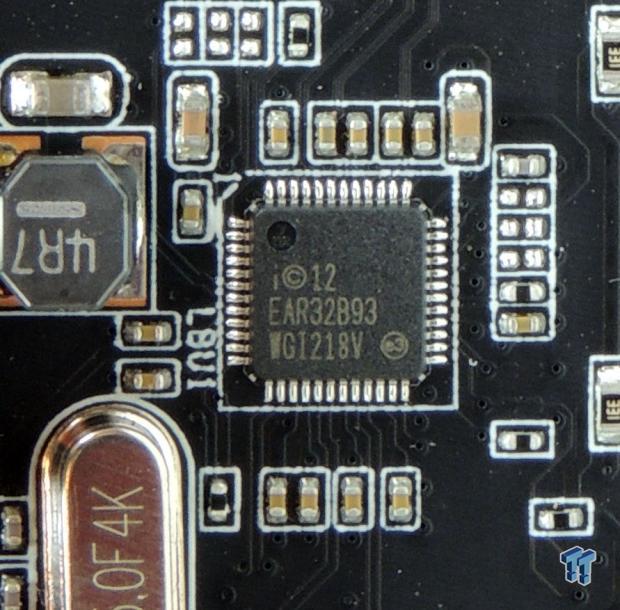
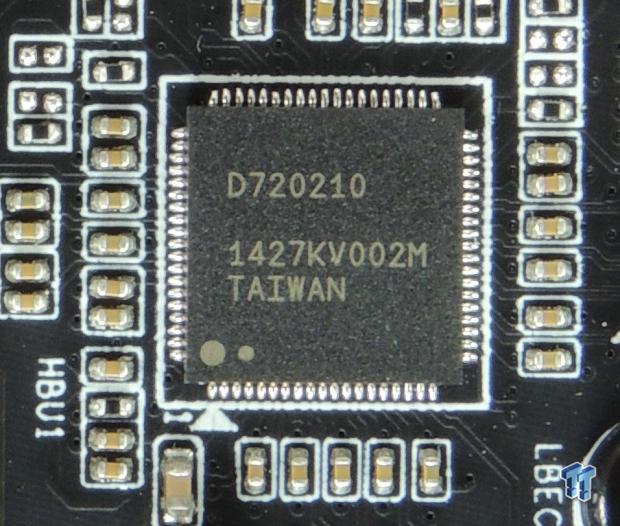
On the left is the Intel i218v that is a common complementary chip to the Intel NIC in the PCH. On the right is a NEC D720210, which is a 1:4 USB 3.0 hub to expand USB 3.0 to the backpanel.

The audio is powered by an ALC1150 that complements the Intel Azalia codec in the PCH.
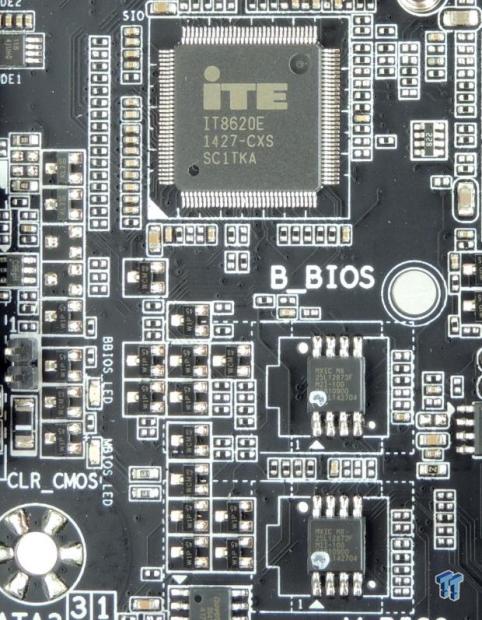
These are the dual BIOS ROMs, each at 128Mbit/16MB. The main Super I/O which handles temperature, voltage, and fan monitoring and control is located right above it. The Super I/O is an iTE8620E complemented by four nuvoTon NCT3941S chips for fan control and secondary and tertiary embedded controllers. I will cover this in greater detail very soon.
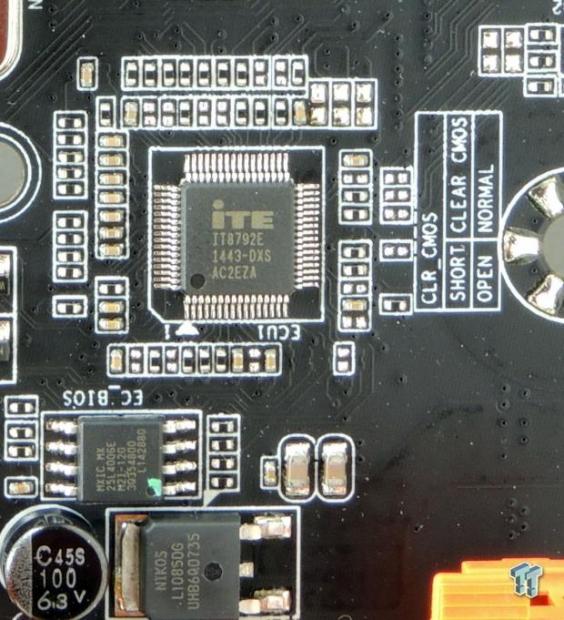
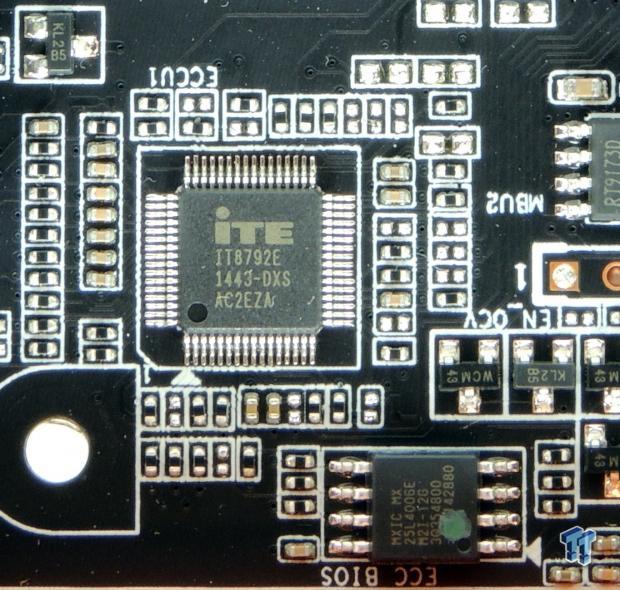
These are the EC (embedded controller) chips responsible for OC functions. The first one is the one you typically find on GIGABYTE X99 motherboards that regulates fan control and basic OC features, but the second one is special for the socket and DIMMs.
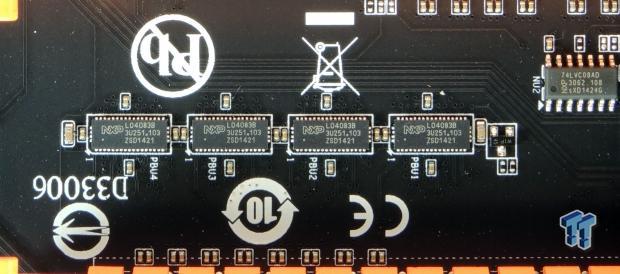
These are NXP 2x PCI-E quick switches; they switch 8x of PCI-E 3.0 bandwidth from the first slot to the second when needed.
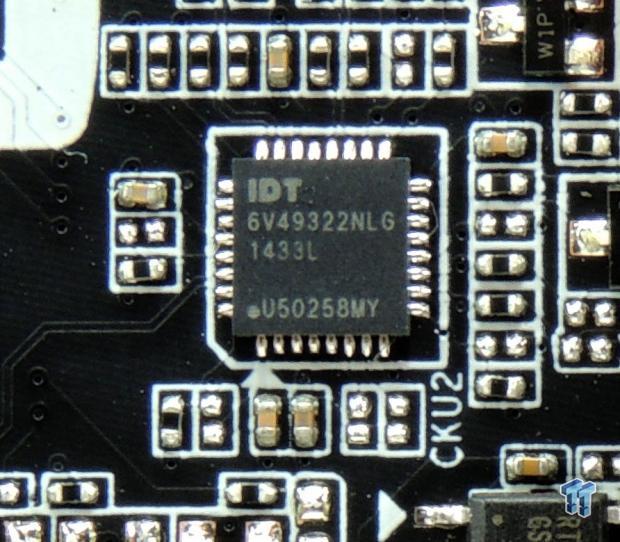
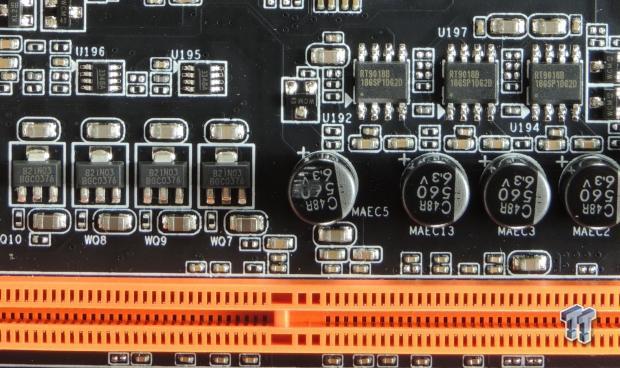
A secondary clock generator has been added to help BCLK overclocking, and this board seems to have extra linear regulators to help power the extra voltage rails for the extra pins in the socket.
BIOS and Software
BIOS
GIGABYTE basically has three operating modes for the UEFI, which are sort of like the easy and advanced modes in other UEFIs. You really just want to use the gray and black themed one known as the classic shell. When you first boot, you will see an orange and black themed BIOS menu with large boxes; this is for novice users to handle I/O configuration. If you press F2 you will get to the classic shell where things work much better. Overall, the classic shell works well and doesn't have many bugs or issues.
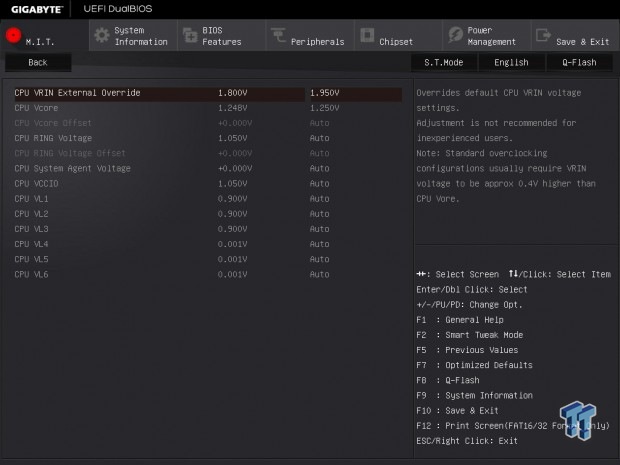
If you switch the socket selector from LGA2011 to LGA2083, extra voltages will appear under the voltage menu. VL4, VL5, and VL6 will control the other VLs, so you only really need to set those. Increasing their values to 1.4-1.5v each will help increase uncore overclocking and decrease the amount of needed VCCSA for higher memory clocks. It depends on the CPU, but VL6 is pretty important.
Try setting it to 1.4v, and then increasing it slowly towards 1.45v. You might be able to boot at 1.45v, but not at 1.47v. However, in Windows (with the latest GTL) you should be able to get a few extra millivolts into VL6 after booting. VCCSA of around +0.5v is usually required for 32x memory divider to work.
Many boards increase this on auto without your knowledge, but when VLs are increased, you will only need about +0.2-+0.3v to attain the same levels of memory overclocking. Uncore is the biggest gain from the socket. Make sure to also set the normal ring voltage as well since it is separate from the VLs.
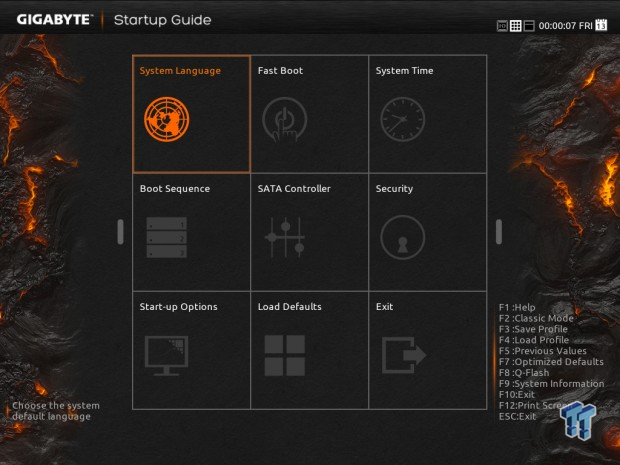
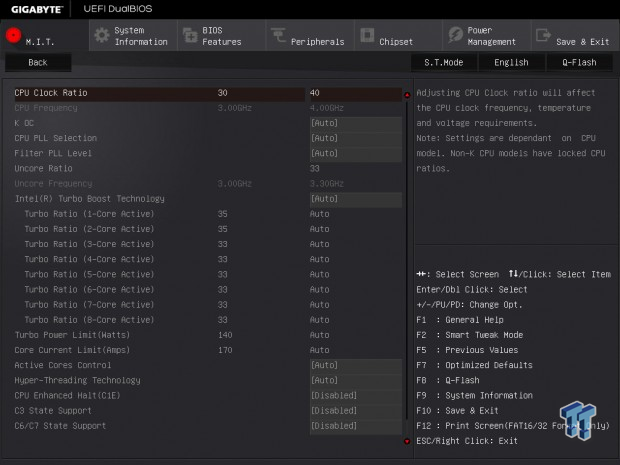
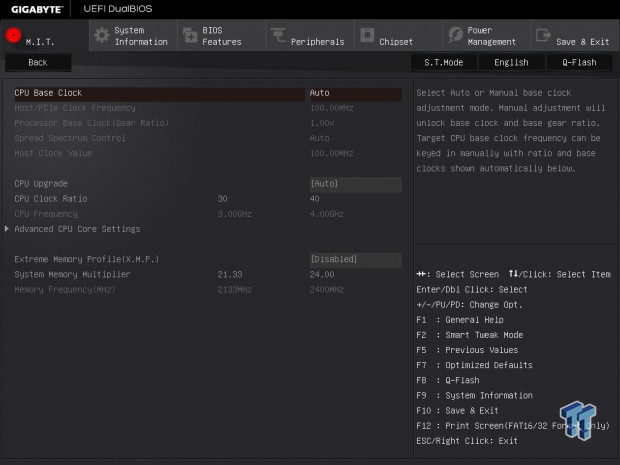
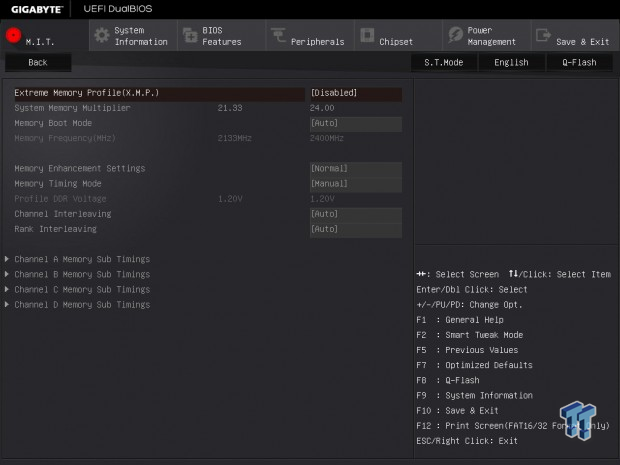
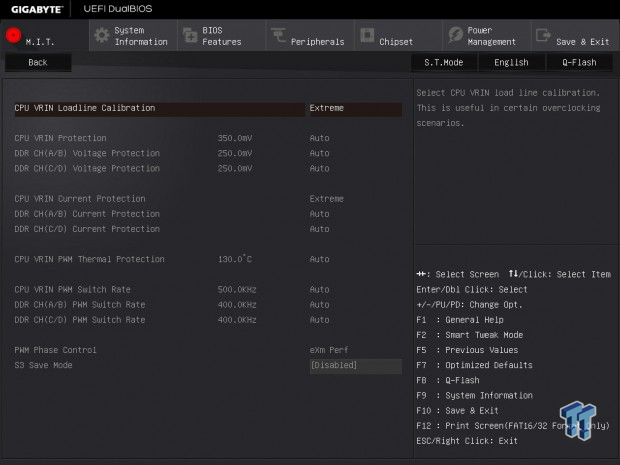
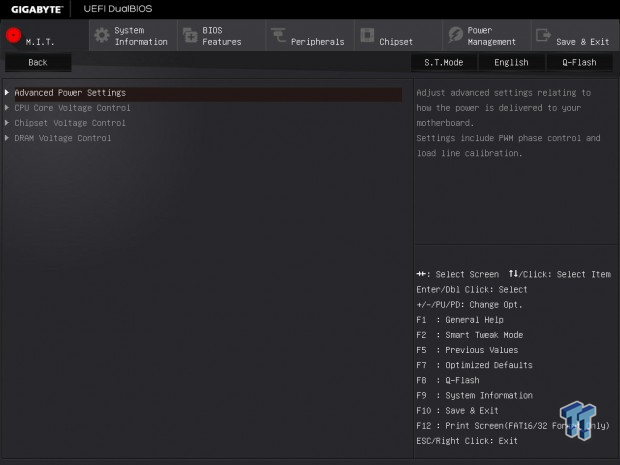
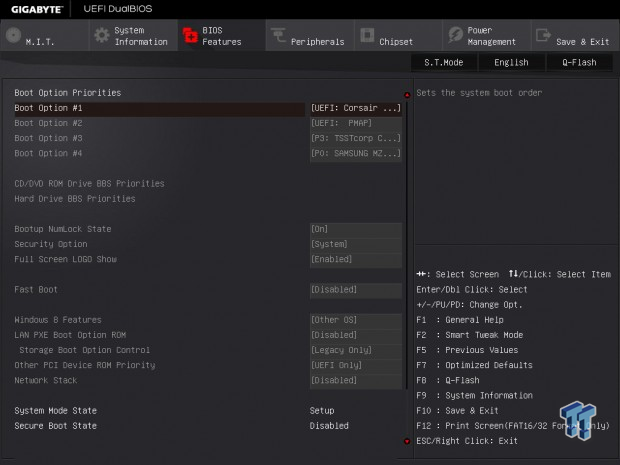
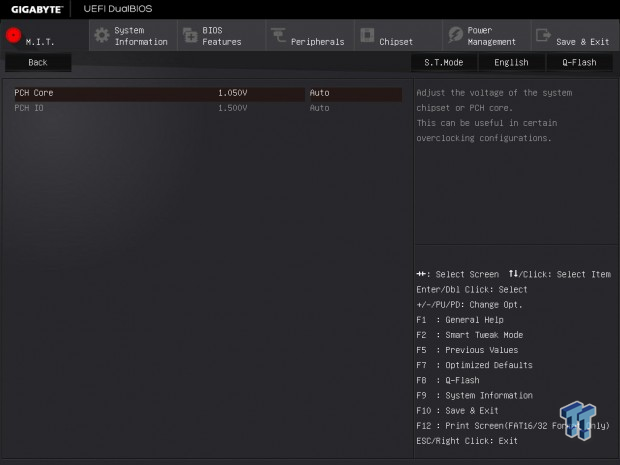
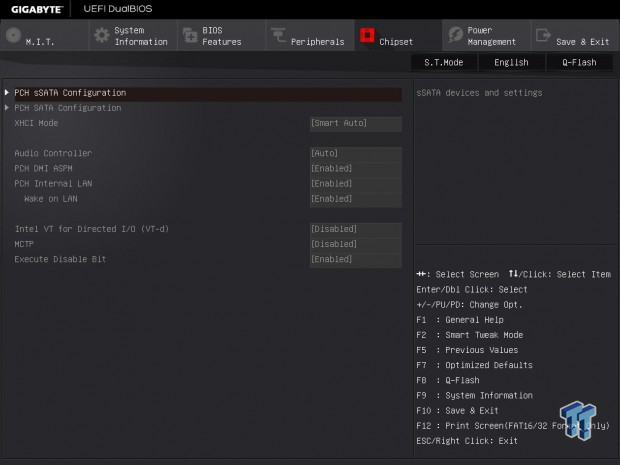
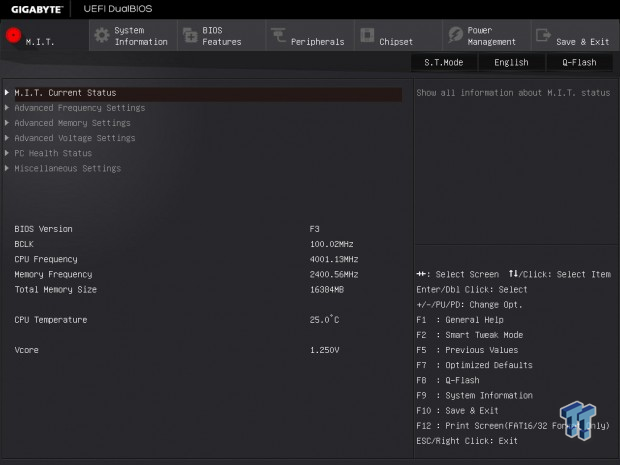
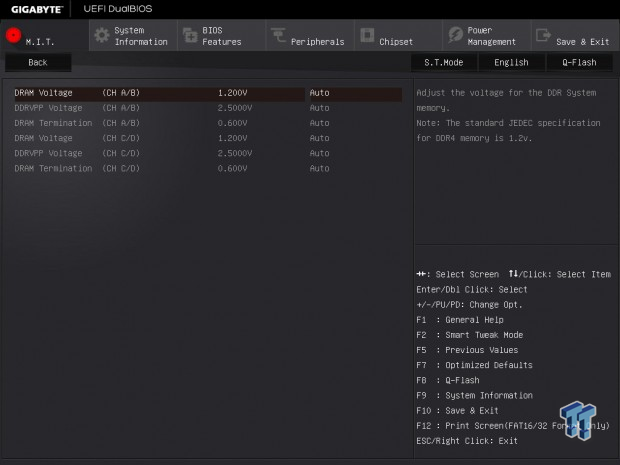
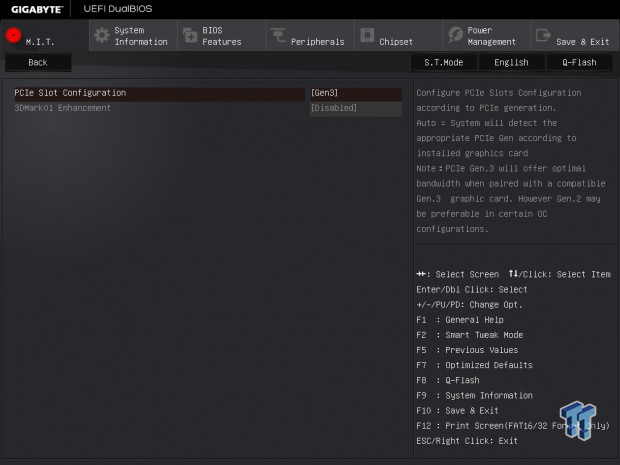
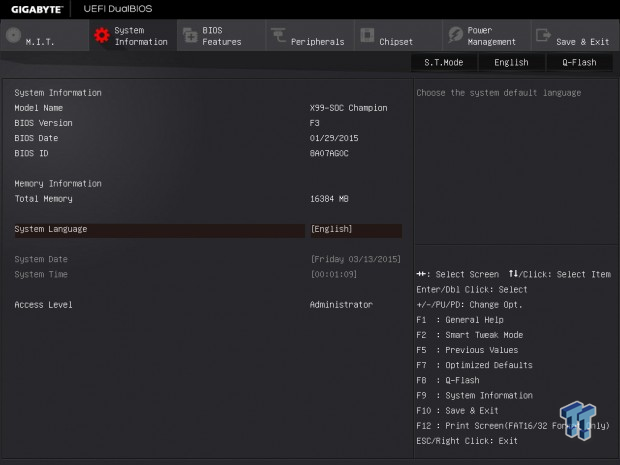
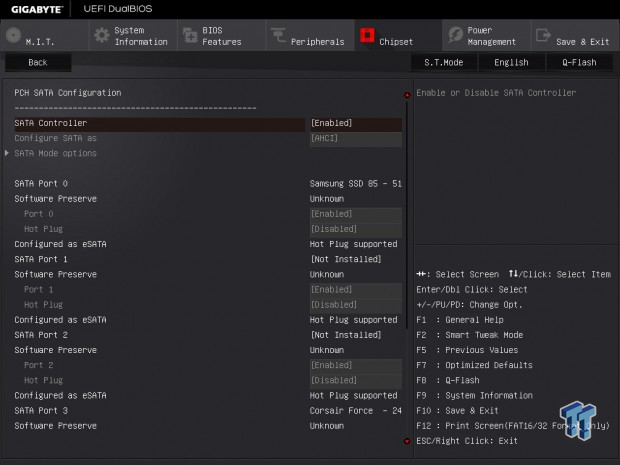
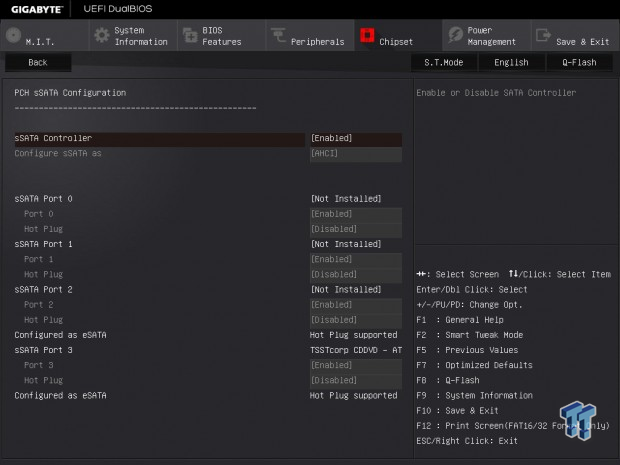
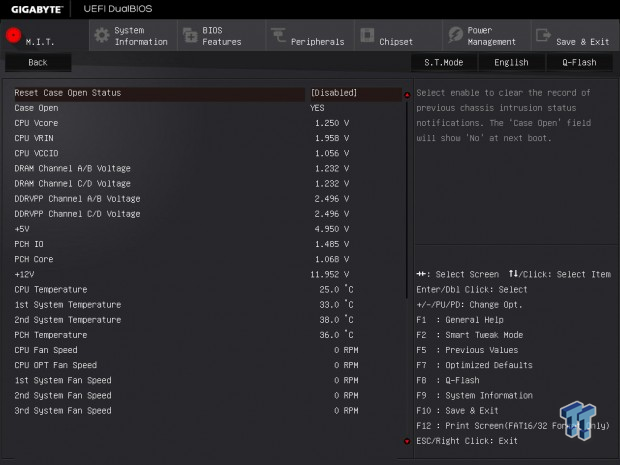
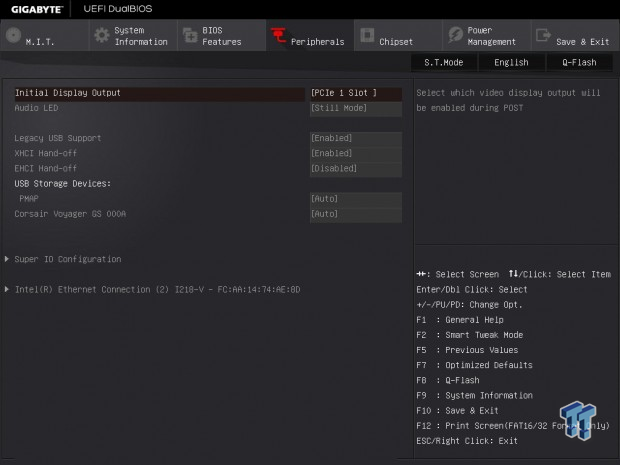
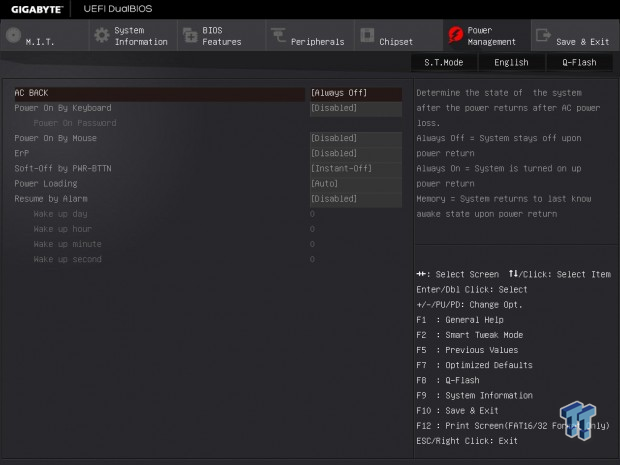
Software
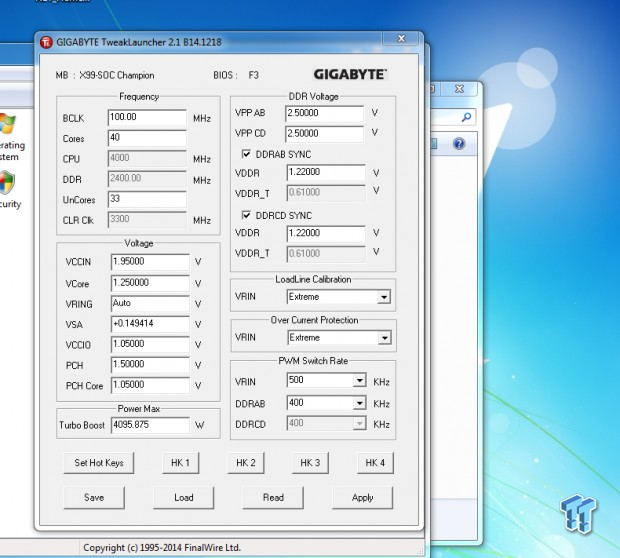
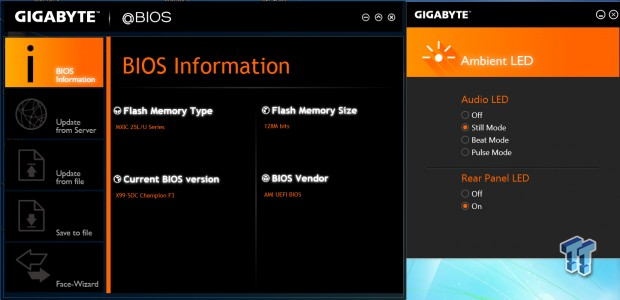
GIGABYTE Tweak Launcher is possibly the most important software for the X99-SOC Champion; it lets you change things on-the-fly. GIGABYTE's @BIOS is also present, and it lets you flash the BIOS in Windows.
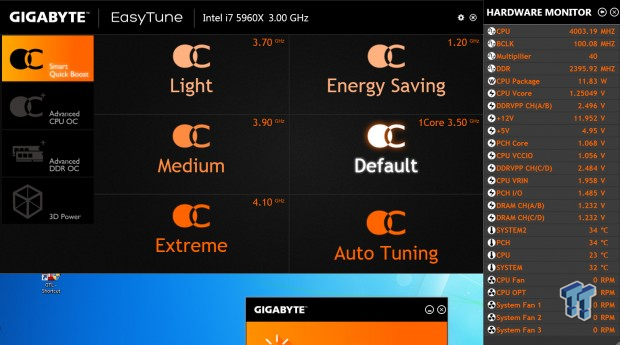
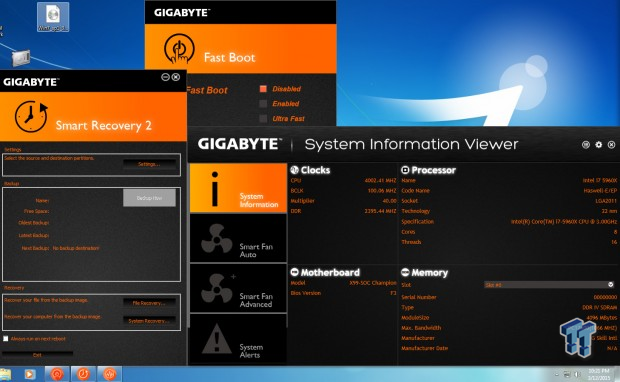
EasyTune will help the novice with preset overclock profiles, and system information viewer allows you to see all the motherboard statistics.
Test Setup and Overclocking
Test Setup
We would like to extend a big thank you to Corsair for sponsoring our case, fans, SSD, USB drive, and PSU!
We would also like to extend our gratitude to Seekfor sponsoring the Thermal Camera. You can find my review of the camera here.
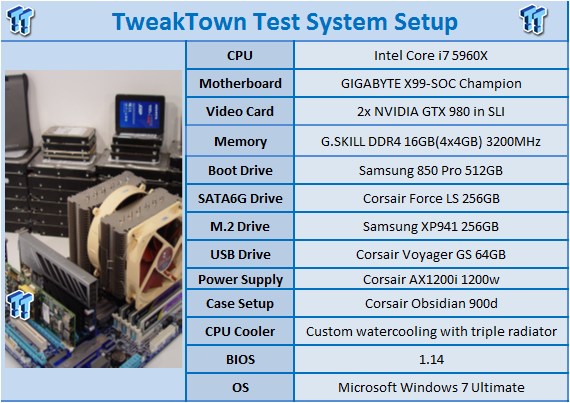
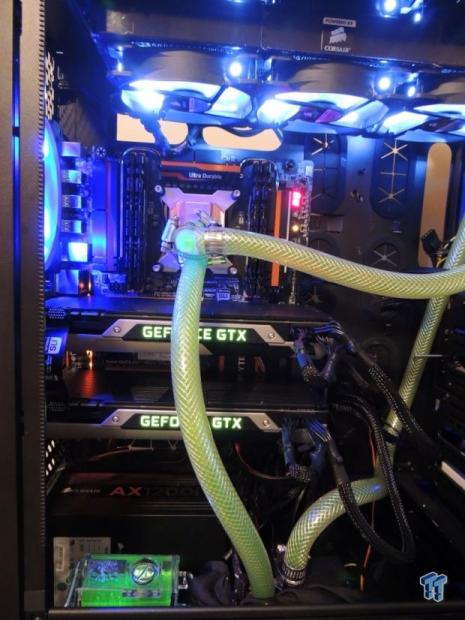
This is the new test bench, and it is designed to test every aspect of the motherboard and I/O. I have designed it so that the motherboard sits in a case and is cooled by fans that are always on at a constant rate to keep the conditions similar for all tests. I have cut out part of the case behind the motherboard so I can get thermal images of the back of the PCB where the VRM heat spreads. System and CPU power measurements are now digitally logged.
I am also using a Netgear Nighthawk X4 AC2350 for our network tests, including wireless AC. The latest M.2, SSD, and USB technologies are also utilized to test the maximum potential of the motherboards that are being tested.
Overclocking Results
In this section, I will explore the overclocking process and results of this board.
CPU Overclocking
Max CPU Overclock is found by setting the VCore to 1.5v, input voltage to 2.1v, and cache voltage to 1.15v; booting with a CPU multiplier of 45x; and disabling any features that would result in CPU frequency fluctuation. Then, proceed to Windows and use software to increase the multiplier; in this case I opted to use GTL.
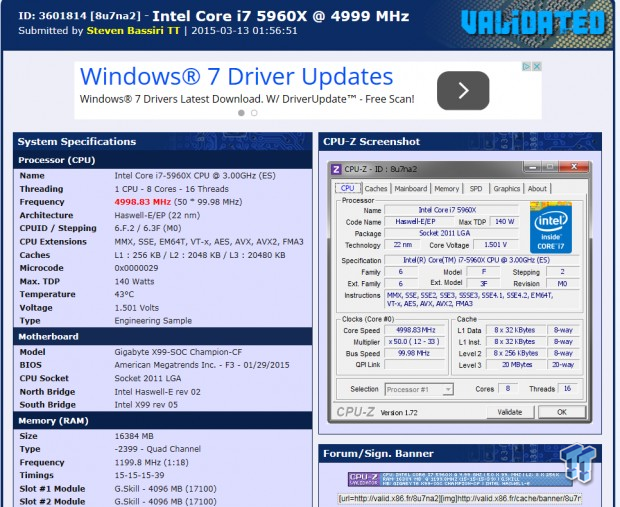
The maximum of our CPU on this board, and other X99 motherboards, is 5.0GHz. It is clear that CPU overclocking is pretty good for high frequency.
Maximum AIDA64 Stable Overclock (BIOS settings for this are below):
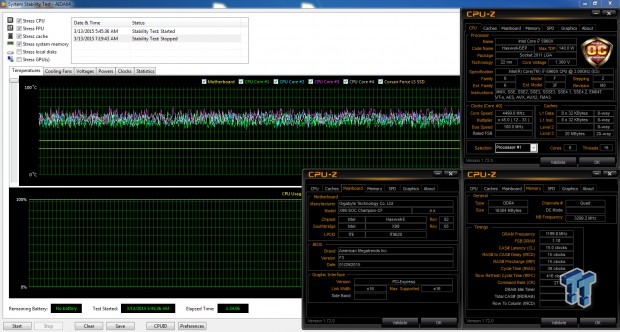
I was easily able to pull off 4.5GHz on the CPU with 3.2GHz cache, and a 2400MHz overclock on my memory by manually tuning the UEFI.
Uncore Overclocking
I usually don't cover cache/uncore overclocking since it really doesn't help users who overclock on air or water, and on the majority of boards the uncore speed maxes out at 3.8GHz which is enough for above ambient overclocks. This maximum can be overcome with a modification to the CPU itself, but not many people are going to solder the pads on the bottom of their CPU.
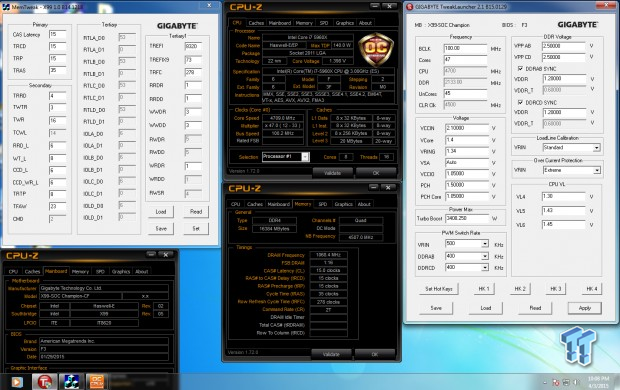
However, the LGA2011-V3 socket with the extra pins such as ASUS's OC Socket and GIGABYTE's LGA2083 socket provide the ability to overclock the uncore way above what other boards without the socket or CPUs without the mod can do. Up to now every board I have reviewed can only overclock the uncore to around 3.8GHz, that includes the SOC Champion's big brother the SOC Force. The X99 SOC Champion can do 4.5GHz Uncore.
CPU, Memory, and System Benchmarks
CINEBENCH 11.5
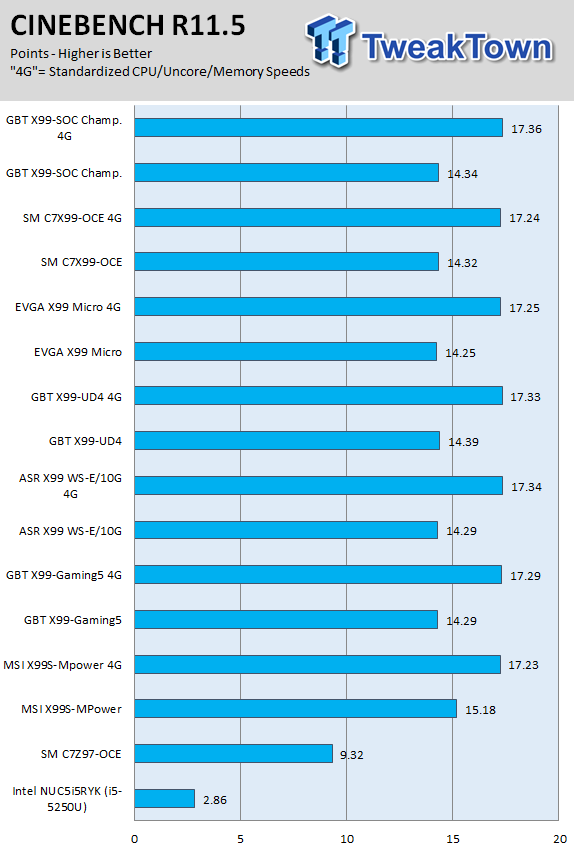
wPrime
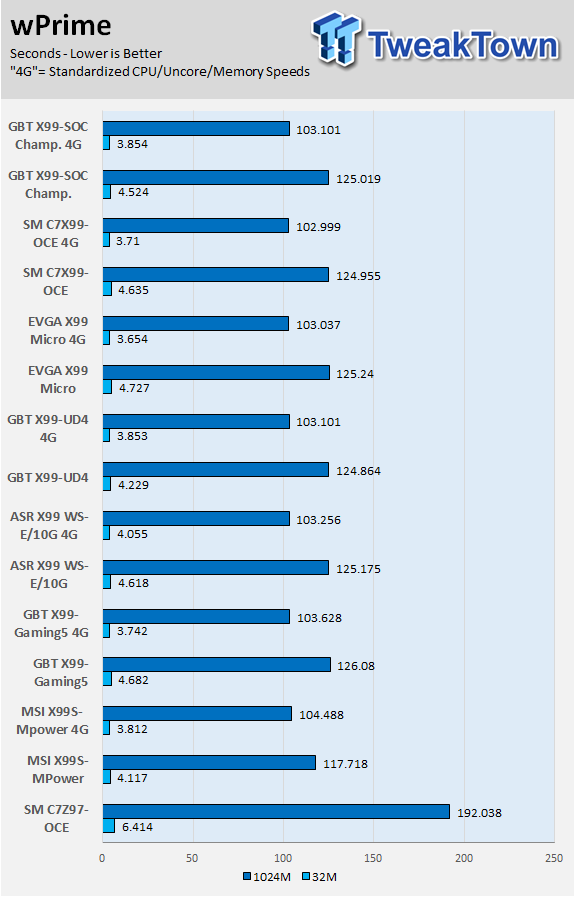
AIDA64 AES and HASH
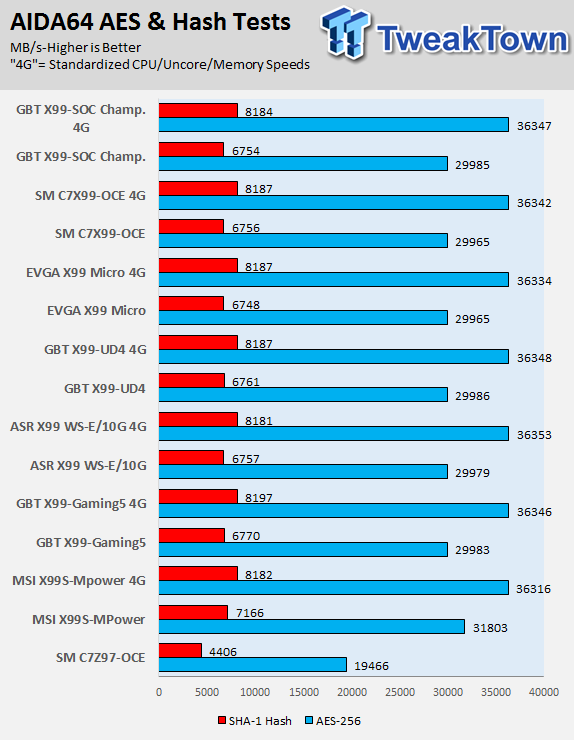
AIDA64 FPU
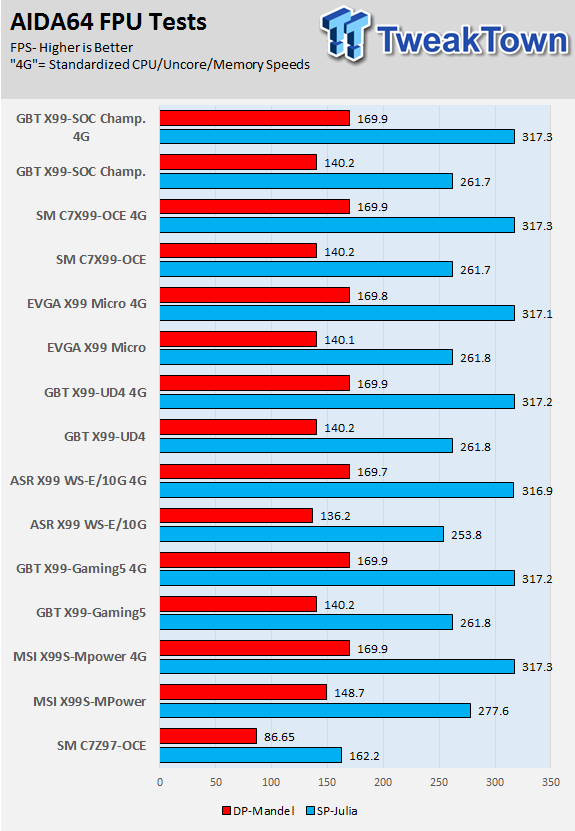
AIDA64 Memory
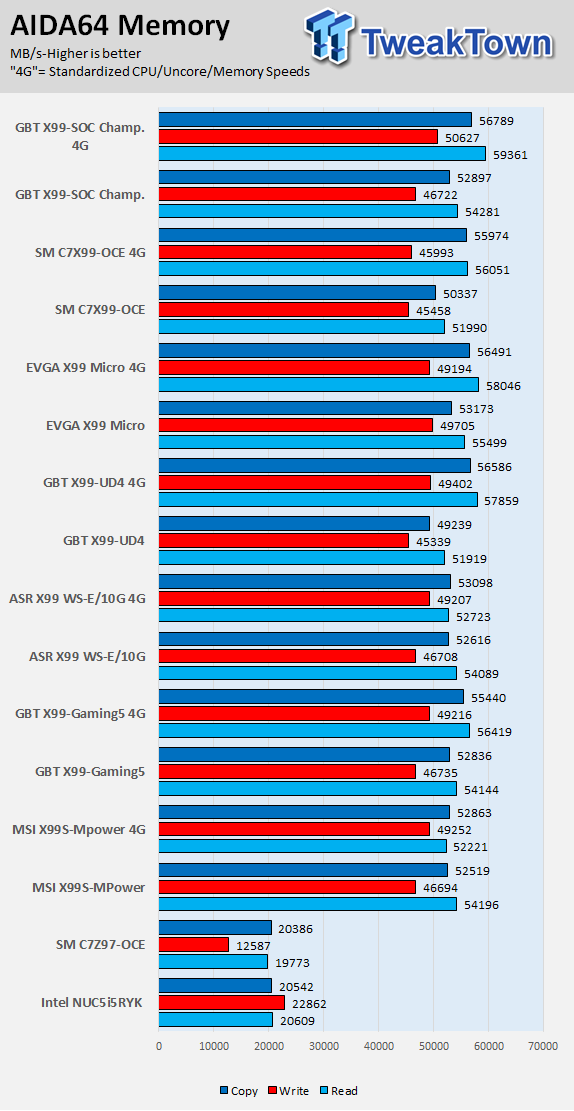
PCMark8 Home Test
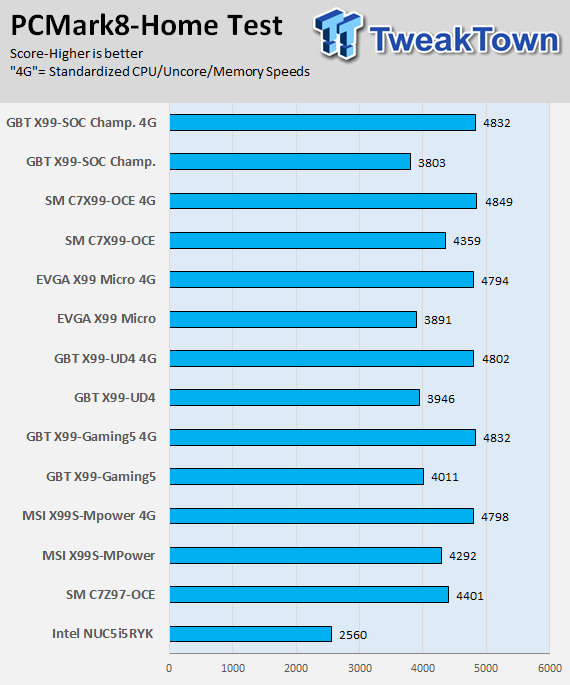
3DMark: Cloud Gate
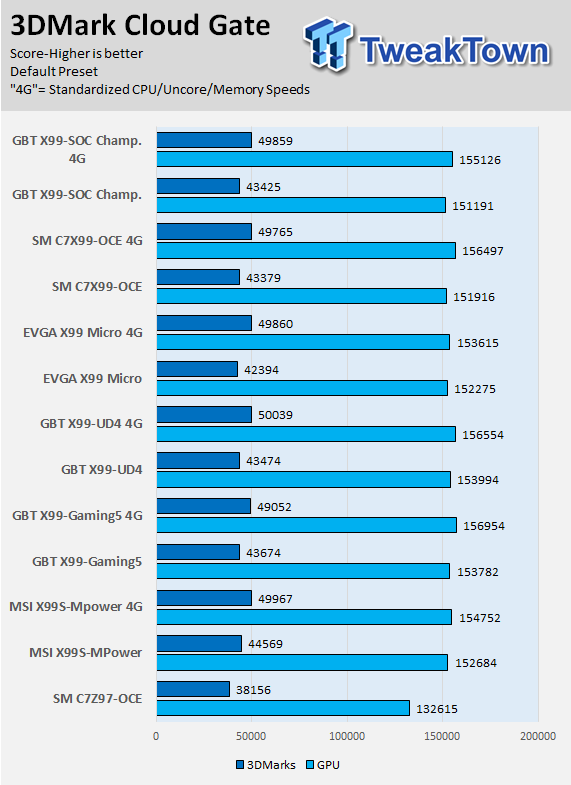
3DMark: Fire Strike
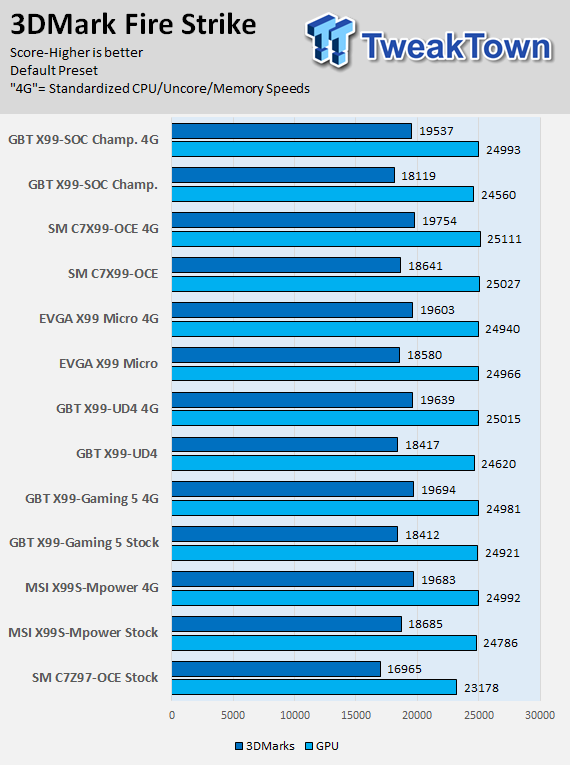
Resident Evil 6
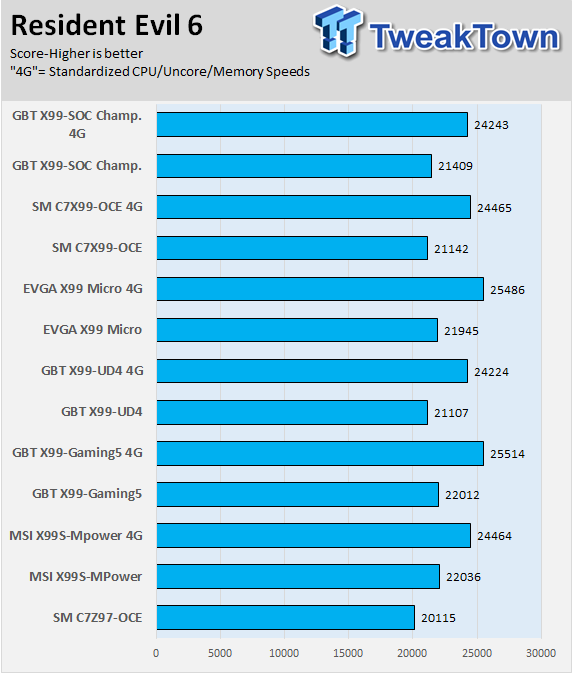
Overall, performance is surprisingly strong. The memory performance is the strongest I have seen so far, and the CPU and graphics scores are also toward the top of the charts. This board is built for overclocking, but basic performance is increased, perhaps as a side effect of the features that are removed.
System IO Benchmarks
Anvil SATA6G:
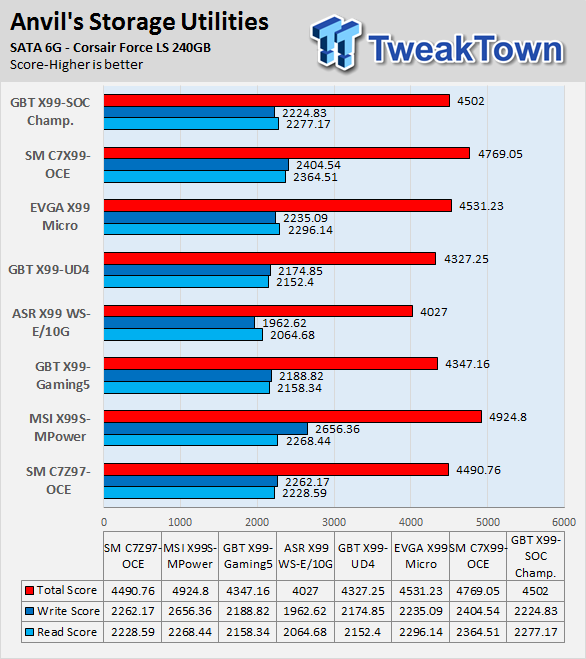
Anvil M.2:
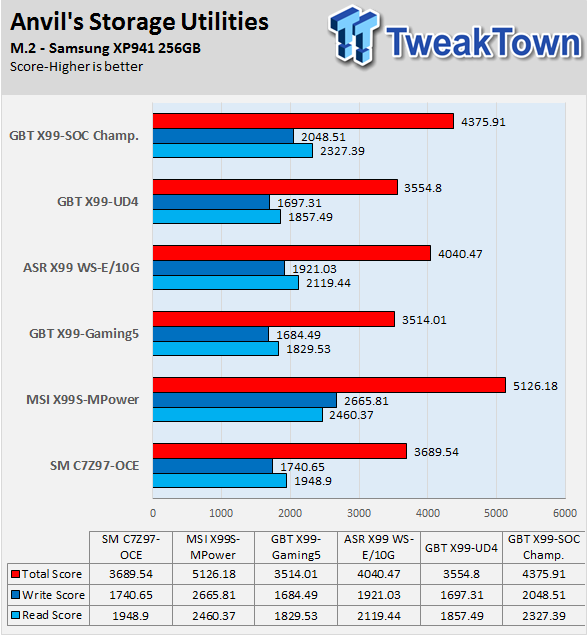
Diskbench USB 3.0:
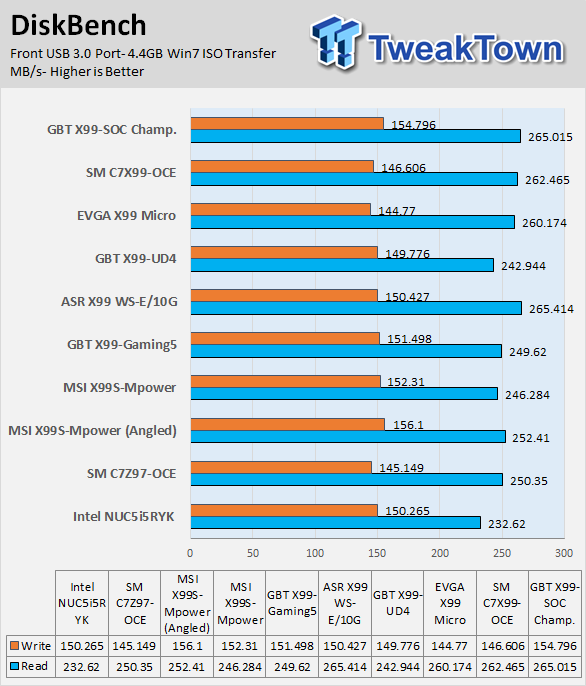
ixChariot Network Throughput:
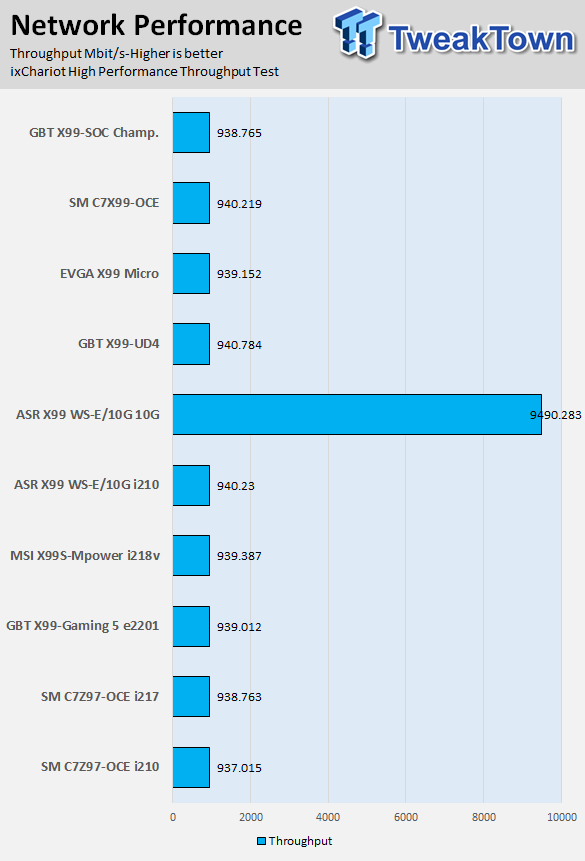
I/O performance is where I expected it to be with an Intel NIC and 4x of PCI-E bandwidth for the M.2 slot. Overall, performance is quite good.
Audio RMAA 5.5:
I disabled all audio features, set the correct bitrates, and then test the audio with a loopback test.
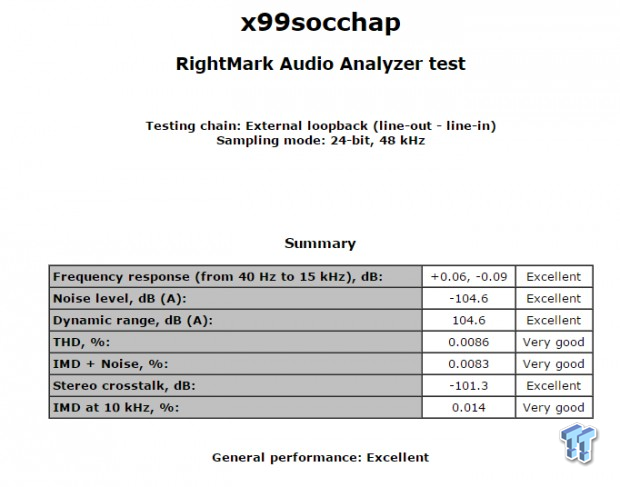
There are five ratings for the audio: 1. Problems, 2. Okay, 3. Acceptable, 4. Very good, 5. Excellent
Judging by ear, the sound is very good.
Temperature and Power Consumption
System power usage is measured at the AC/DC PSU (the Corsair AX1200i), which I have connected to another system to measure the test system, and I have a wall meter as a backup to verify. The CPU power is measured through the eight-pin connection, which is hooked up to a hall effect IC that measures current and puts out a voltage in proportion to the current. A National Instruments ADC logs that voltage; afterward, I convert that into current.
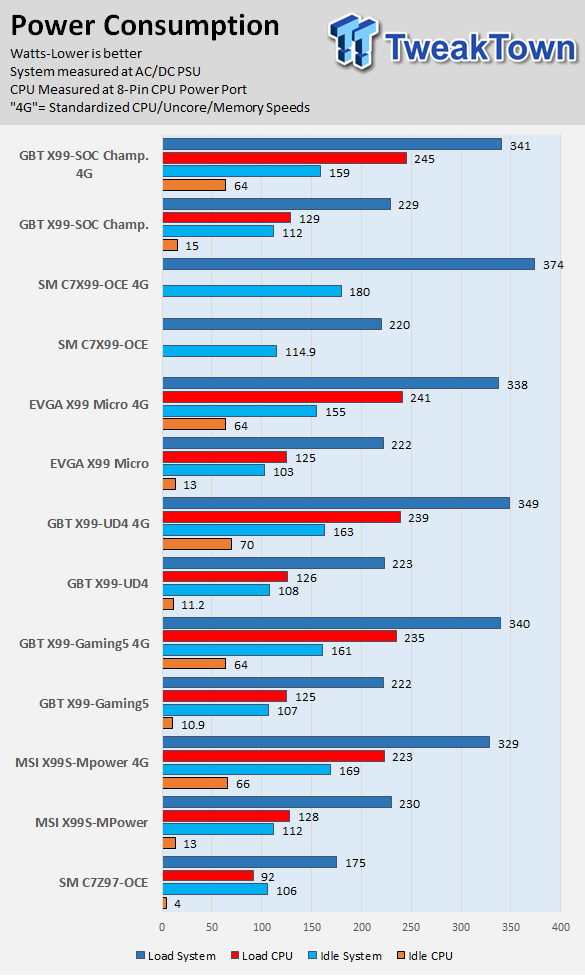
Note on Thermal Images: In the temperature section, we use our Seek thermal imaging camera to capture the surface temperatures of major components on the board. I look at the VRM, and then all other things that light up the screen. If there is something to worry about, then I will state it; otherwise, I will just show the hotter running parts of the board for fun. Unless a component is over 80-90C, then there really isn't anything to worry about.
All systems will act differently, so I will look for commonalities, such as how far from the VRM the heat spreads through the PCB, and the difference in temperature between the front side and backside of the PCB. Keep in mind that the majority of the heat from the VRM goes into the PCB as it is a giant soldered-on copper heat sink. A smaller difference in temperature between the back and front of the PCB points towards a more effective heat sink.
Thermal Testing at Stock Speeds:
The image on the left is always at idle, and the image on the right is at load.
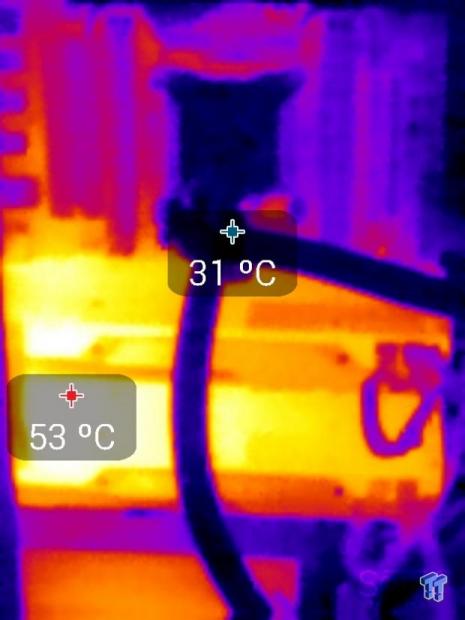
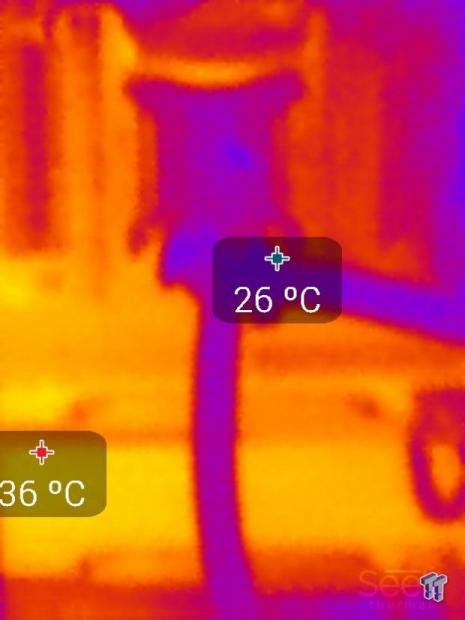
Here is full frontal.
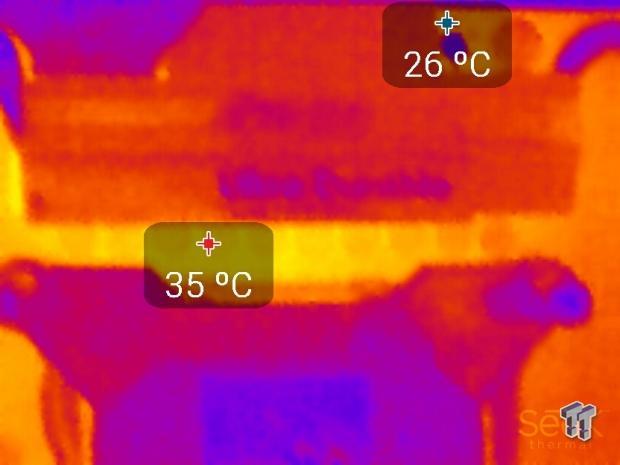
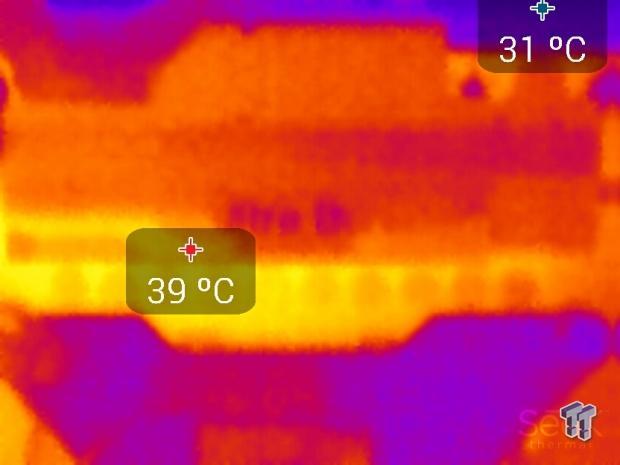
This is up close to the front of the VRM.
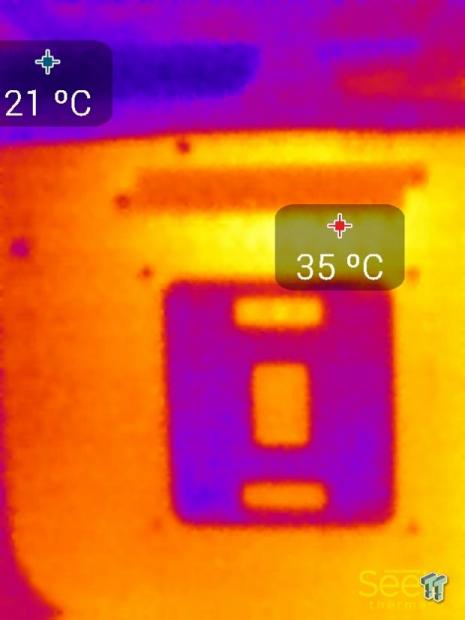
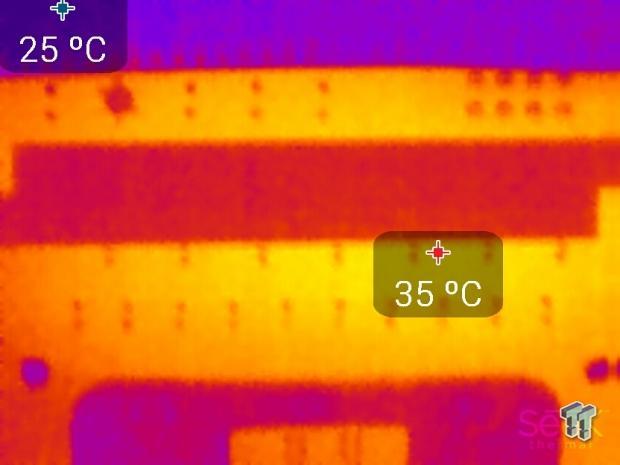
This is up close to the back of the VRM.
Thermal Testing at 4.5GHz Overclocked Speeds:

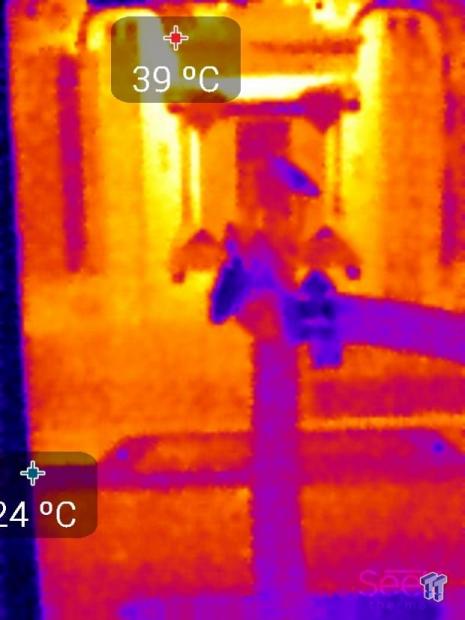
Here is full frontal.
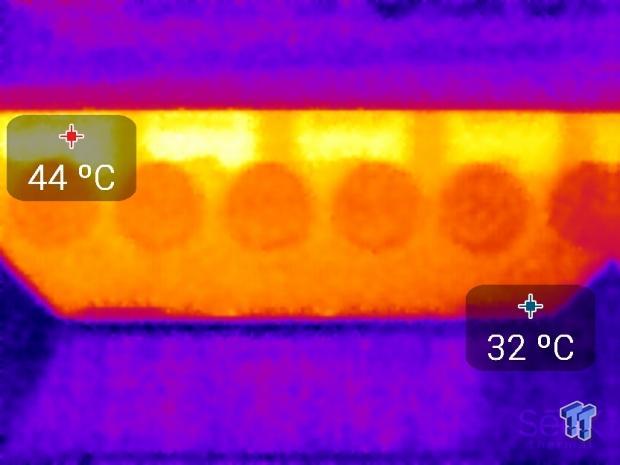
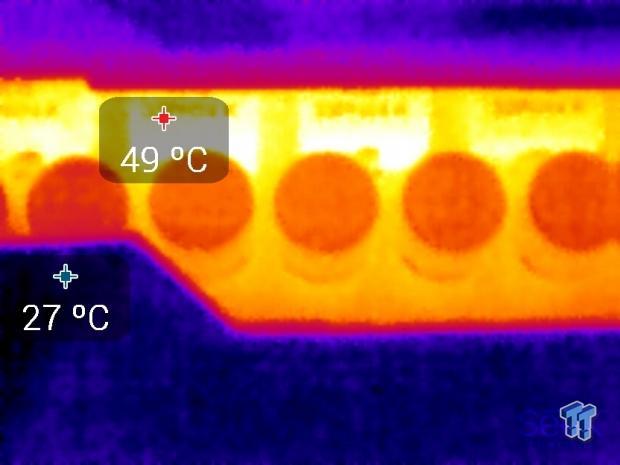
This is up close to the front of the VRM.
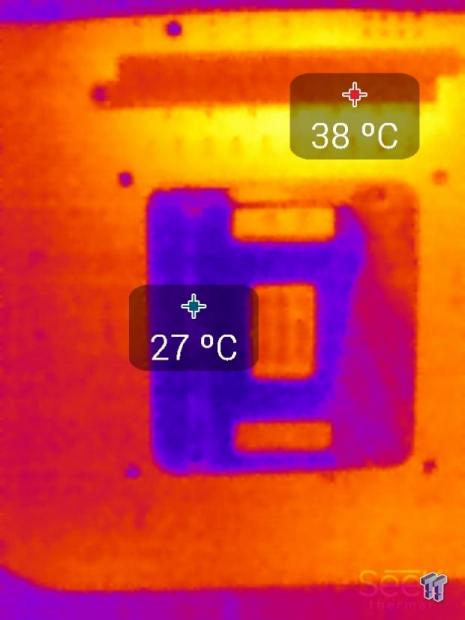
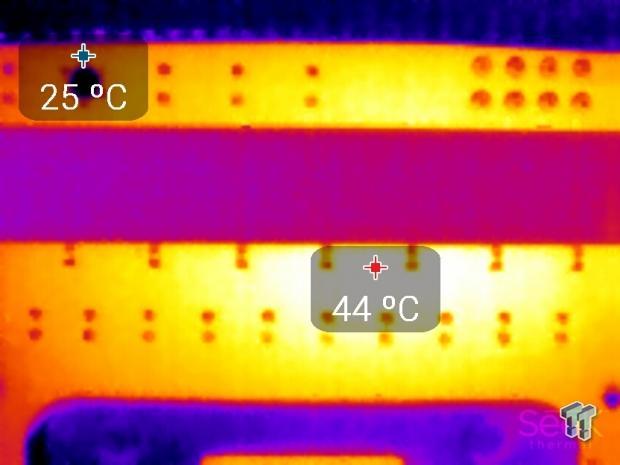
This is up close to the back of the VRM.
It is pretty clear that the VRM handles load very well since the temperature difference between idle and load is very small. The heat sink does a great job because you don't see the back at a higher temperature than the front.
Also, even though the heat spreads from idle to load, in the overclocked tests, the temperature of the hotspot didn't change from idle to load when looking at the whole system. You can see that there is a 5C increase in the overclocked tests in the front and a 6C increase at the back of the VRM. This minimal temperature increase is a good sign. Temperatures were always at totally acceptable levels.
Final Thoughts
The X99-SOC Champion is one of GIGABYTE's best overclocking boards, and revives the reputation they had back in the X58 days with the original X58A-OC. This is not only because of the LGA2083 socket, which is a huge benefit for extreme overclockers, but it is also because of its overall price and performance.
While the overclocking tests in this review don't hit upon the strong points of the socket, I have tested this board under liquid nitrogen and pushed the uncore much higher than I could on most other boards. You are usually limited to about 3.7-3.8GHz on the uncore with the normal LGA2011 socket, but on boards with the extra pins, you can push over 4GHz and towards 5GHz.
While this is kind of worthless for anyone overclocking on air or water, for those using liquid nitrogen, it can come in handy to break world records. This is a very simple board to overclock, and all of the tools are right there on the board.
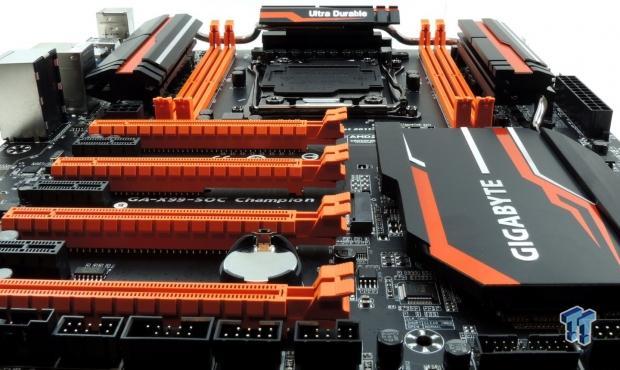
There is a drawback to one of the main overclocking features, and that is the fact that this board has only four DIMMs. This means you need to buy a high density memory kit if you want over 16GB of DDR4, which isn't a big deal for me, but it might matter to those looking at content creation. However, this board is designed for overclocking, and perhaps little else. While it is designed for overclocking, you can easily use this for anything you might do with an X99 system. The performance of the X99-SOC Champion, both in benchmarks and thermal testing, makes it an ideal candidate for anyone looking for a solid X99 motherboard.
At $300, it is a great catch considering other boards with the same reputation can cost 50% more. I would say that the X99-SOC Champion lives up to its name, and is in fact an overclocking champion. If you are looking to break world records, and don't want to rob a bank, the X99-SOC Champion might just be the right board for you.
PRICING: You can find the X99-SOC Champion for sale below. The prices listed are valid at the time of writing, but can change at any time. Click the link to see the very latest pricing for the best deal.
United States: The X99-SOC Champion retails for $299.99 at Amazon
Australia: The X99-SOC Champion retails for $539.00 at PLE Computers.

| Performance (including Overclocking) | 98% |
| Quality including Design and Build | 95% |
| General Features | 90% |
| Bundle and Packaging | 90% |
| Value for Money | 92% |
| Overall | 93% |
The Bottom Line: I would say that the GBT X99-SOC Champion lives up to its name and is in fact an overclocking champion. If you are in the market to break world records and don't want to rob a bank, the X99-SOC Champion might be the right board for you.
PRICING: You can find products similar to this one for sale below.
 United
States: Find other tech and computer products like this
over at Amazon.com
United
States: Find other tech and computer products like this
over at Amazon.com
 United
Kingdom: Find other tech and computer products like this
over at Amazon.co.uk
United
Kingdom: Find other tech and computer products like this
over at Amazon.co.uk
 Australia:
Find other tech and computer products like this over at Amazon.com.au
Australia:
Find other tech and computer products like this over at Amazon.com.au
 Canada:
Find other tech and computer products like this over at Amazon.ca
Canada:
Find other tech and computer products like this over at Amazon.ca
 Deutschland:
Finde andere Technik- und Computerprodukte wie dieses auf Amazon.de
Deutschland:
Finde andere Technik- und Computerprodukte wie dieses auf Amazon.de
Related Tags
